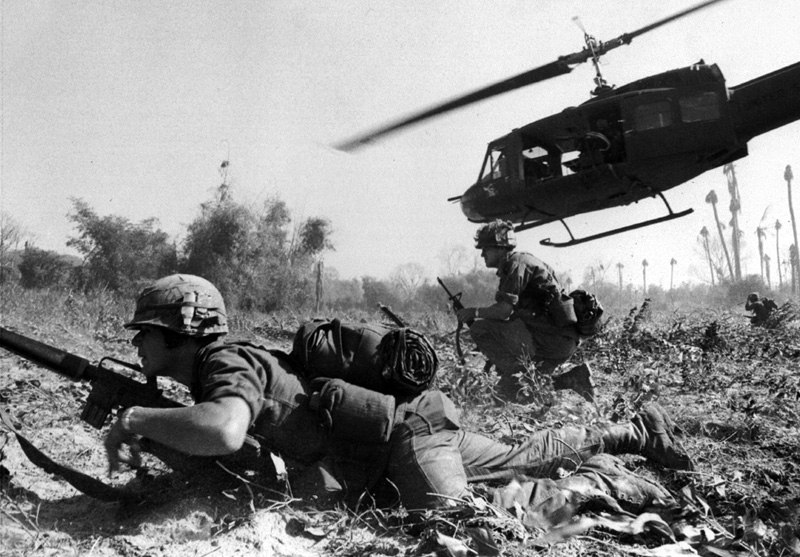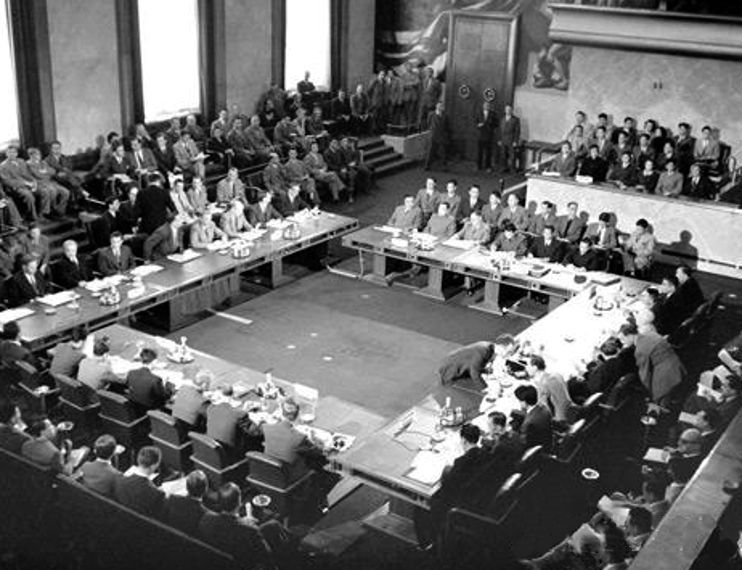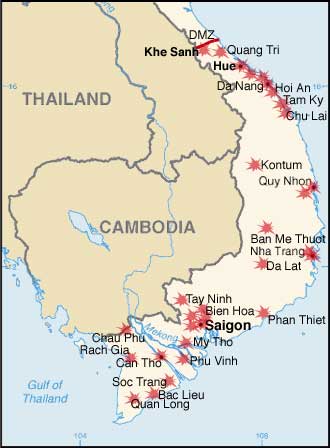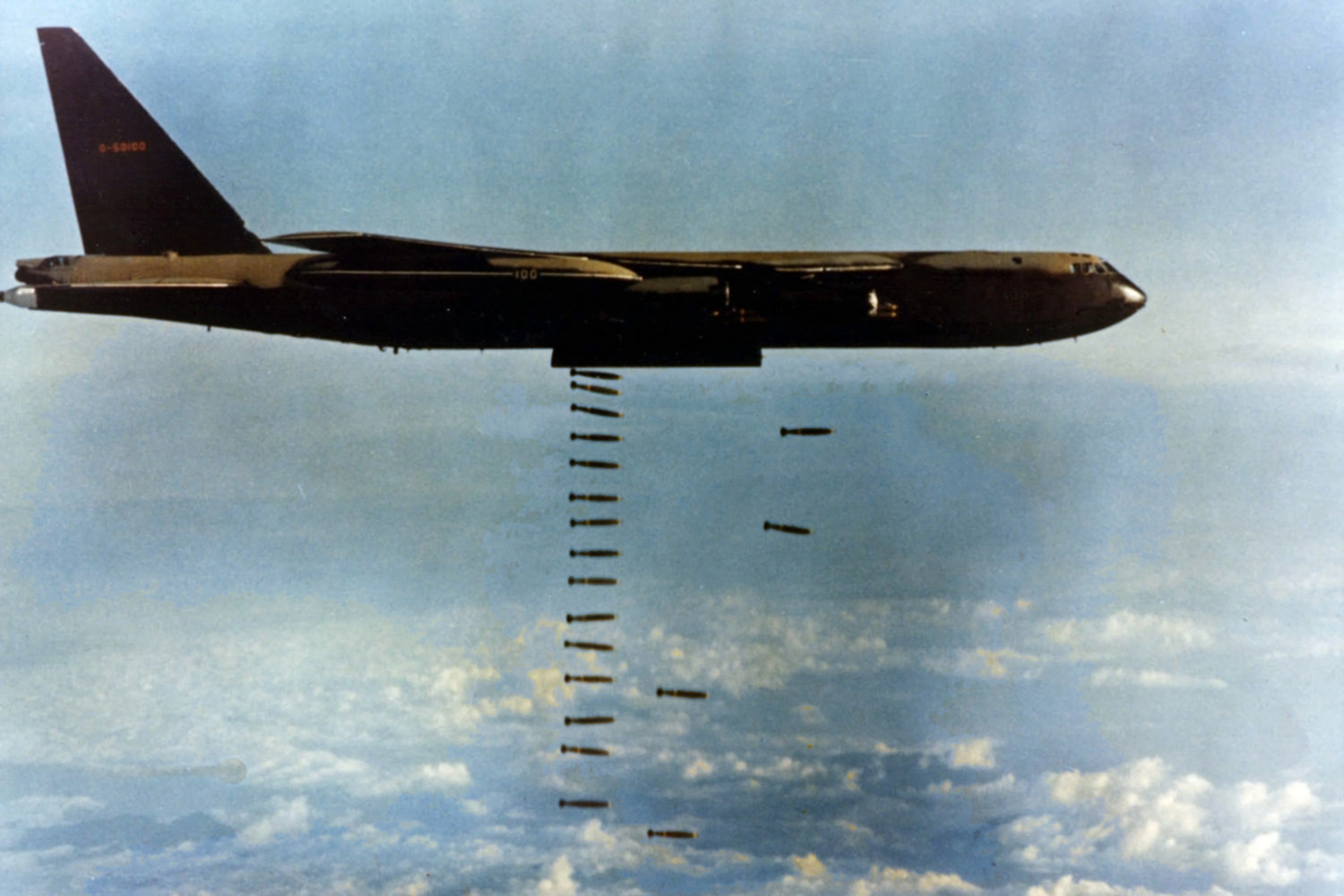Who?
US Presidents: Dwight Eisenhower, John F Kennedy, Lyndon B Johnson, Richard Nixon
Other US personnel: General Westmoreland (Johnson administration), Henry Kissinger (Nixon-Ford administration, National Security adviser and Secretary of State)
South Vietnam leaders: Ngo Dinh Diem (Prime Minister: 1960-1963), Nguyen Van Thieu (President: 1967-1971)
North Vietnam leaders: Ho Chi Minh, Tran Van Tra (Leading commander in Vietcong), Ton Duc Thrang (First president of Socialist Republic of Vietnam (Unified Vietnam))
What?
Vietnam, like Korea, was split into North and South. However, initially, the North was under the Nationalist Chinese while the South was under the British. It was only after the communists gained victory in China, that the North started to be more inclined towards communism. And it was once again the ideology differences and the same intention to unify the country that started the war.
When?
26 September 1959 to 30 April 1970
How?
Prelude
Before World War II, Vietnam was part of the French Indochina, which consisted of present day Laos and Cambodia as well. However, since the French was a defeated power in World War II, the British and the Nationalist Chinese split Vietnam into two charges. (Initially however, Ho Chi Minh, leader of Viet Minh, the communist movement, had declared Vietnam independent) However, after the communists took over China, they began supplying weapons to the Viet Minh to fight against the French, which sparked the First Indochina War.
(French exit)
With the French exit and declaration of independence to its former colonies at the 1954 Geneva conference, Vietnam was split into North and South Vietnam, with a demilitarized zone between the two states along the 17th parallel. A socialist state was established in North Vietnam under Ho Chi Minh, while a monarchy, non-communist state under Emperor Bao Dai, who was used as a puppet emperor during the French and Japanese occupation, was established in the South.
Diem era
Ngo Dinh Diem, South Vietnam’s Prime Minister, had rejected the proposal of the UN at the Geneva Conference to hold free elections in Vietnam. While he publicly criticized the North for not being able to hold “free” elections, he knew himself that if these elections were held, he and Emperor Bao Dai would be ousted from power as Ho Chi Minh would gain a landslide victory.
Diem gradually rose to power, from being named as premier by Emperor Bao Dai to being President of the new Republic of Vietnam (The polls were rigged in his favour), and he initiated the “Denounce the Communists” campaign, during which communists and suspected communists were arrested, imprisoned, tortured or executed.
From 1956 to 1960, there were insurgents in the South, assassinating government officials initially, then gradually expanded to school teachers, healthcare workers, village heads, etc. who were mainly symbols of the current Republic. Ho Chi Minh had also mentioned to his insurgents, that they should “not engage in military operations; that will lead to defeat. Do not take land from a peasant. Emphasize nationalism rather than communism. Do not antagonize anyone if you can avoid it. Be selective in your violence. If an assassination is necessary, use a knife, not a rifle or grenade. It is too easy to kill innocent bystanders with guns and bombs, and accidental killing of the innocent bystanders will alienate peasants from the revolution. Once an assassination has taken place, make sure peasants know why the killing occurred." This strategy became known as armed propaganda.
A report from US officials, during this period, had also shown that majority of the population in the South in fact support Ho Chi Minh, which was why the four year insurgency was somewhat a success.
Kennedy’s administration
During John F Kennedy’s administration, he paid little attention to Laos, Cambodia and Vietnam despite Eisenhower’s warnings about it as to Kennedy, Europe and Latin America were more important. He however, was interested in sending counterinsurgency forces to Third World countries such as Vietnam.
Kennedy also believed that Diem would ultimately defeat the guerillas on his own, and that American intervention would only lead to adverse consequences. Yet, Kennedy, upon the advice of his advisers, decided to increase military presence in Vietnam.
Also, the military was corrupt and had bad leadership, which led to the downfall of the Army of Republic of Vietnam (ARVN), and helped the guerilla insurgency gain momentum.
In response, the South Vietnam government initiated the Strategic Hamlet Programme in 1961, which aimed to resettle the rural population into fortified camps so that they were isolated from the insurgents, and were provided education and healthcare. This programme, even though it was to help the government strengthen its hold over the countryside, failed badly as the programme was soon infiltrated by the guerillas. Furthermore, the peasants hated being taken away from their villages, and paying high rents to landlords. (Government refused to implement land reforms) With increased corruption and opposition towards the programme, government officials were targeted for assassination.
The Army was evidently weak by now, and the discontent of population was starting to show. On Vesak Day, the Buddha’s birthday, Buddhists protesting against the ban of the Buddhist flag were shot down, and more protests arose, protesting over government-implemented policies which favoured the Catholics but not the Buddhists. (N.B. Almost 80% of Vietnamese are Buddhists)
By 1963, a coup to overthrow Diem was initiated and Diem, together with his brother who was a hated figure in South Vietnam already, was overthrown and executed. Following the coup, South Vietnam entered a period of political instability, as one military government toppled after the other, and North Vietnam took advantage of this to increase support to the insurgents.
The US government aimed to pacify and “win over the hearts and minds” of the population, while the military, with differing views, supported fighting, and was confident of a victory by 1963.
Lyndon B. Johnson’s administration
Johnson, similar to Kennedy, was unconcerned about Vietnam initially; however, after realizing the threat a communist, unified Vietnam could bring to the region, Johnson reversed Kennedy’s disengagement policy and increased the troop number to expand the war.
President Johnson's speech on Vietnam
Both sides were rapidly expanding their armies. The Viet Cong’s army strength rose from 850000 to about a million men, while the number of US troops deployed to Vietnam rose from 2000 to 16500 in three years.
The National Security Council recommended bombing North Vietnam and the National Front for the Liberation of South Vietnam (NLF) to force North Vietnam to cease their support for the NLF in the South. However, the operations, which lasted for three years, failed badly as it killed many innocent lives while bombing the ground from an airplane.
In 1965, the expansion of the war was confirmed, and by sending US Marines to South Vietnam, it marked the beginning of the American ground war, and the US public strongly supported this as they felt that US involvement was to stop the expansion of communism. Ho Chi Minh had also warned the Americans that if they “want to make war for twenty years then we shall make war for twenty years. If they want to make peace, we shall make peace and invite them to afternoon tea.” However, it was noted by a South Vietnamese Cabinet minister that the primary goal of the war to the South Vietnamese was to reunify Vietnam and secure its independence. On the other hand, the Democratic Republic of Vietnam (North Vietnam) had a policy not to topple other non-communist government in South East Asia.
General William Westmoreland made use of the aggressive nature of the marines who were sent for defensive purposes to outline a three-point plan to win the war:
§Phase 1. Commitment of US (and other free world) forces necessary to halt the losing trend by the end of 1965.
§Phase 2. US and allied forces mount major offensive actions to seize the initiative to destroy guerrilla and organized enemy forces. This phase would be concluded when the enemy had been worn down, thrown on the defensive, and driven back from major populated areas.
§Phase 3. If the enemy persisted, a period of twelve to eighteen months following Phase 2 would be required for the final destruction of enemy forces remaining in remote base areas.

By now, the US had changed its policy from allowing the South Vietnam government to manage its own affairs to military intervention to stop the continuing loss of the AVRN. However, with the change in policy, there was a huge surge in corruption in Saigon (capital of South Vietnam, present day Ho Chi Minh City)
America had also encouraged its Southeast Asia Treaty Organisation (SEATO) members to bring military aid in. Despite the military escalation, the guerilla insurgents were still tactically flexible and remained elusive. In 1967, the political situation in South Vietnam was rather stabilised with the coming to power of President Nguyen Van Thieu. This long-awaited calm since Diem’s execution helped the ARVN to collaborate with its allies and become a better a better fighting force.
Back in America, however, the Johnson administration’s “policy of minimum candor” damaged public trust in official announcements, which led to the development of a credibility gap between the public and the Pentagon. Some protesters chanted phrases like “Ho, Ho, Ho Chi Minh! The NLF is going to win!” and, “hey, LBJ! How many boys did you kill today?” during a large anti-war demonstration in 1967.
In 1968, the NLF broke the supposed truce on Tet (Lunar New Year), and launched surprise offensives in over 100 cities, with the hope of sparking a national uprising. Though the Americans and South Vietnamese were taken aback initially, they responded quickly and effectively, and a notable example would be the Battle of Hue, where the American forces used massive firepower, which left 80% of the city in ruins. After the Vietnam War, North Vietnamese officials had acknowledged that the Tet Offensive was a failure to them and caused damage to NLF forces. Yet, the offensive had another unintended consequence…
American man fleeing in Battle of Hue
General Westmoreland spearheaded a public relations drive for President Lyndon B. Johnson to gather public support, and in one of his speeches, he said that the war had reached a point “where the end comes into view.” With the Tet offensive, Westmoreland’s predictions were contradicted, and the credibility gap was getting wider, which effectively ended Johnson’s political career. This turn of events helped the North Vietnamese, as they had won the Americans back in America.
Vietnamization
In 1969, newly installed US President Richard Nixon began troop withdrawals due to severe communist losses in the Tet offensive. This plan, known as the Nixon Doctrine or “Vietnamization” was to build up the ARVN so that they could take over the defense of South Vietnam.
 The ARVN in a training exercise
The ARVN in a training exercise
Nixon had also pursued negotiations with the North Vietnamese, détente (easing of strained relations) with the Soviet Union and rapprochement with the People’s Republic of China (PRC). The détente had helped in reducing nuclear arms on both sides, though Nixon was still disappointed that the PRC and the Soviet Union continued to supply the North Vietnamese with aid.
Though Cambodia had been proclaimed neutral since 1955, the communists still used Cambodian soil as a base and Prince Norodom Sihanouk tolerated this as he did not want to be drawn into a regional conflict. Even though the US had promised him Cambodian neutrality, they still bombed the Cambodia-Vietnam border and deposed of him via Lon Nol, the prince’s pro-American prime minister.
The ARVN launched an operation aimed at cutting the Ho Chi Ming trail in Laos, however, after encountering resistance, they fled confusedly and the Americans had to help them destroy the abandoned equipment. This showed that Vietnamization was a huge failure, as these soldiers, educated by Americans for ten to fifteen years, but yet learnt very little.
By 1972, American ground troops completely withdrawn from South Vietnam, but yet, through various battles, it was evident that the ARVN was unable to defend South Vietnam, and as such the Americans kept their airpower there.
In October that year, Nixon’s National Security Adviser, Henry Kissinger, ended secret negotiations with North Vietnam’s leader Le Duc Tho after reaching an agreement. However, when South Vietnamese president Thieu demanded massive changes to the peace accord, North Vietnam went public with the agreement details, and the negotiations became deadlocked.
To show his support for South Vietnam and force North Vietnam back to the negotiating table, Nixon ordered bombings of North Vietnam and pressured Thieu to accept the agreement. In 1973, the Paris Peace Accords on “Ending the War and Restoring Peace in Vietnam” was signed and direct US involvement was ended, with a cease-fire declared across North and South Vietnam.
Exit of Americans
Under the Paris Peace Accord:
§ Beginning on 27 January 1973 at midnight, Greenwich Mean Time — in Saigon time, 08:00 on 28 January — there would be an in-place ceasefire. North and South Vietnamese forces were to hold their locations. They were permitted to resupply military materials to the extent necessary to replace items consumed in the course of the truce.
§ As soon as the ceasefire is in effect, U.S. troops (along with other foreign soldiers) would begin to withdraw, with withdrawal to be complete within sixty days. Simultaneously, U.S.prisoners of war would be released and allowed to return home. The parties to the agreement agreed to assist in repatriating the remains of the dead.
§ There would be negotiations between the two South Vietnamese parties — Saigon and the Vietcong — towards a political settlement that would allow the South Vietnamese people to "decide themselves the political future of South Viet-Nam through genuinely free and democratic general elections under international supervision."
§ Reunification of Vietnam was to be "carried out step by step through peaceful means."
As the Americans exited South Vietnam, the Vietcong was preparing to recapture the lost territories, and a massive invasion of the South, in the 1975-1976 dry season. Vietcong’s top commander, Tran Van Tra, calculated that this was the best date to launch an offensive before the ARVN could be fully trained. Even though US had completely pulled out of South Vietnam, President Nixon implied that they would intervene militarily if the communist side violated the ceasefire. However, the Congress were against it an passed the Case-Church Amendment to prohibit intervention.
South Vietnam’s economy was greatly damaged in 1973, and the Vietcong took this advantage to recapture their lost territories. It was then President Thieu announced that the Vietnam War had restarted and the Paris Peace Accord was no longer in effect. The following year, Gerald Ford took over as US President after the resignation of Richard Nixon.
Meanwhile, Tra was pushing for an offensive on South Vietnam, and the North Vietnamese launched a limited offensive on Phuoc Binh, the provisional capital of Phuoc Long province, and Ford desperately asked the Congress for funds to help the South, which the Congress refused. The fall of Phuoc Binh demoralized the South Vietnamese greatly and boosted the morale of the North Vietnamese. Even though in 1975, the South Vietnamese were more militarily capable than the North, the North were well-organised, highly determined and well-funded, and this gave the North the edge they needed over the South.
Campaign 275 was then launched by the North Vietnamese, and captured their target- Ban Me Thuot in Daklak province. In just one day, the North Vietnamese overran the ARVN. President Nguyen Van Thieu was fearful of a huge defeat to prepare for the defence of Saigon, but due to irresponsible leadership and the poor conditions of retreating paths, many ARVN troops were lost and captured by the North Vietnamese. On 20 March, Thieu contradicted his orders and ordered Hue to be held at all costs. His contradictory orders confused his officers and when the North Vietnamese launched their attack, panic overcame the ARVN forces and they retreated in a panicky manner. After just 3 days, Hue fell, and 100,000 ARVN troops without their leaders surrendered to the North.
The North then launched the final offensive against Saigon. On 7 April, they attacked Xuan Loc, and even though the North met fierce resistance at Xuan Loc, the ARVN defenders gave in and surrendered. After the loss of Xuan Loc, President Thieu resigned on the same day, declaring that the US had betrayed South Vietnam: “At the time of the peace agreement the United States agreed to replace equipment on a one-by-one basis.But the United States did not keep its word. Is an American's word reliable these days?...The United States did not keep its promise to help us fight for freedom and it was in the same fight that the United States lost 50,000 of its young men.”
By April end, the North Vietnamese troops had defeated the ARVN and encircled Saigon. The US then brought in helicopters to evacuate civilians in what was known as Operation Frequent Wind. President Gerald Ford then declared the end of the Vietnam War and all US aid.
Finally, the communists overran the city, and toppled the Saigon regime and 116 years of foreign occupation and involvement.
Why?
The communist North was determined to reunify the country and made use of peasants unhappiness with the government in the South to do so, starting with insurgencies. Furthermore, Vietnam had been under 116 years of foreign occupation and involvement, starting from the French, then the Japanese, then the British and Chinese, and finally the Americans. If the war was a success, they would be able to break free from pro-American leaders in the South and be an independent nation. Furthermore, Ho Chi Minh had already declared Vietnam independent immediately after the Japanese surrendered, which was not recognized by the US.
Results of the Vietnam War
Casualties
About one-tenth of the population was dead or injured, with the casualty count at 3.58 million civilians and 1.4 million injured on both sides.
Southeast Asia
Cambodia fell to Khmer Rouge, Laos fell to the Pathet Lao, and more than 3 million refugees from Indochina were resettled to other parts of the country, mostly United States.
Vietnam refugees escaping via Operation Frequent Wind
Personal reflections
We feel that the North had indeed made use of advantageous situations, especially when launching the final offensive. A good example was how the Tet Offensive, though a huge loss militarily to the North, had helped destabilise the American support back in America which actually helped them in the closing stages of the war.

Also, the war is a good lesson for everyone that we should never be complacent and look down on others. The Americans had looked down on the North Vietnamese and felt that they were easy to pressure, which was proved wrong before the Paris Peace Accord was signed. As Ho Chi Minh once said: “You can kill ten of my men for every one I kill of yours…But even at these odds you will lose and I will win.” The people the Americans were dealing with were hardcore nationalists and communists who had fought out the French just for independence.
In anything, we should always know thy enemy. Only then can we gain a huge victory.
Superpowers
Soviet Union:
Had a communist ally in Southeast Asia, a strategic place to establish a presence in.
Did not interfere much, just supplied the North with military and monetary aid.
United States:
Learnt important lessons from this war that would model their future military activities.
Civilians
Most civilians were happy that the pro-American government was ousted and that the country was reunified. They were unhappy with the previous South Vietnamese government over the fact that the government was a Catholic one, while majority of the populations were Buddhists. Also, the South Vietnamese government did not care much about the peasants, leaving them to suffer under landlords despite them continuously calling for land reforms.
Physically however, the civilians were affected by the use of chemical defoliants in the war. Some notable ones were the “Rainbow Herbicides”- which included the famous Agent Orange, which by-product is dioxin. Dioxin had caused children to be born with defects and some ill-effects on war veterans.
Post By Ivan Tee







Vietnam lasted till April 30 1975 ... get your dates right...
ReplyDeleteSincerely, Vietnam era Veteran